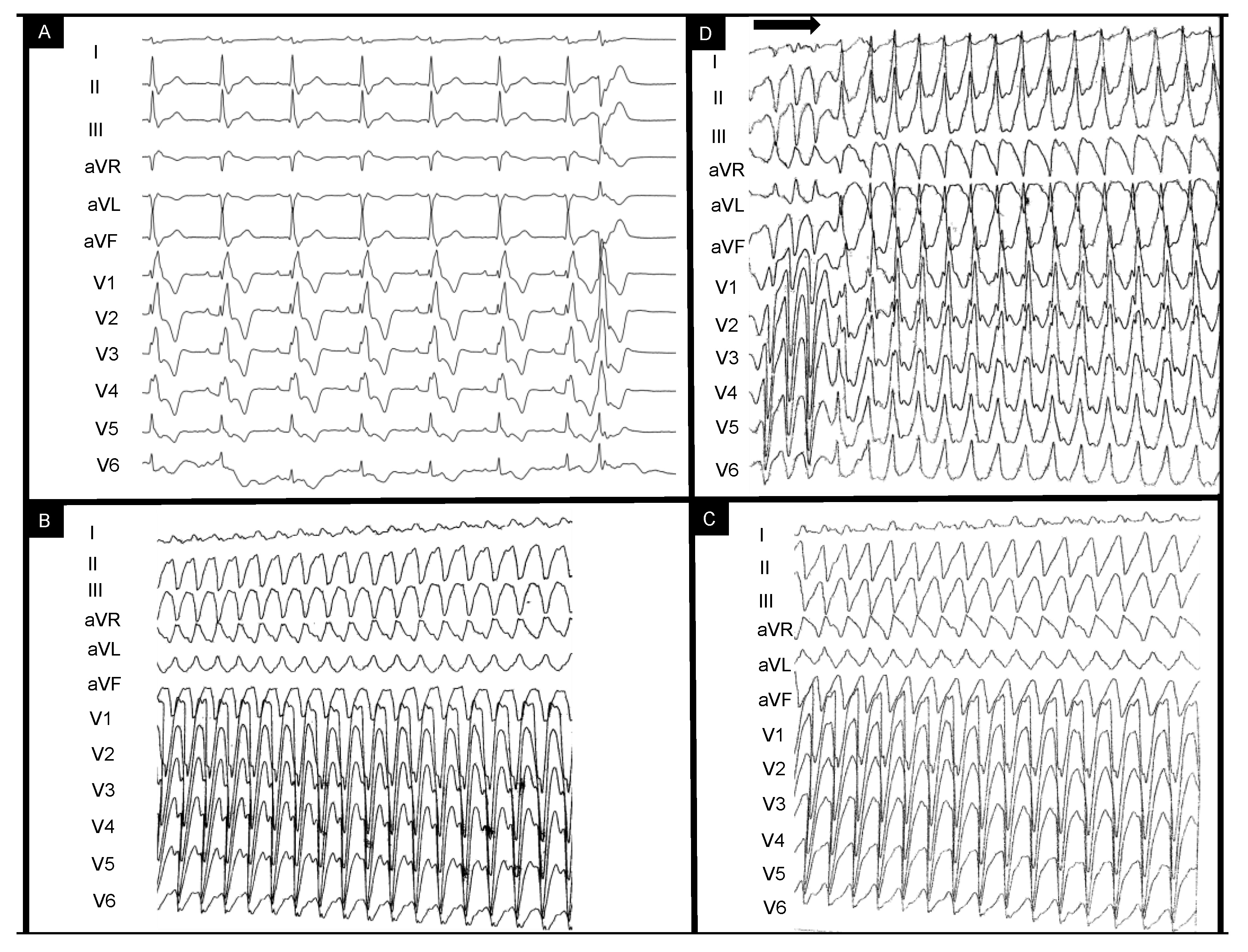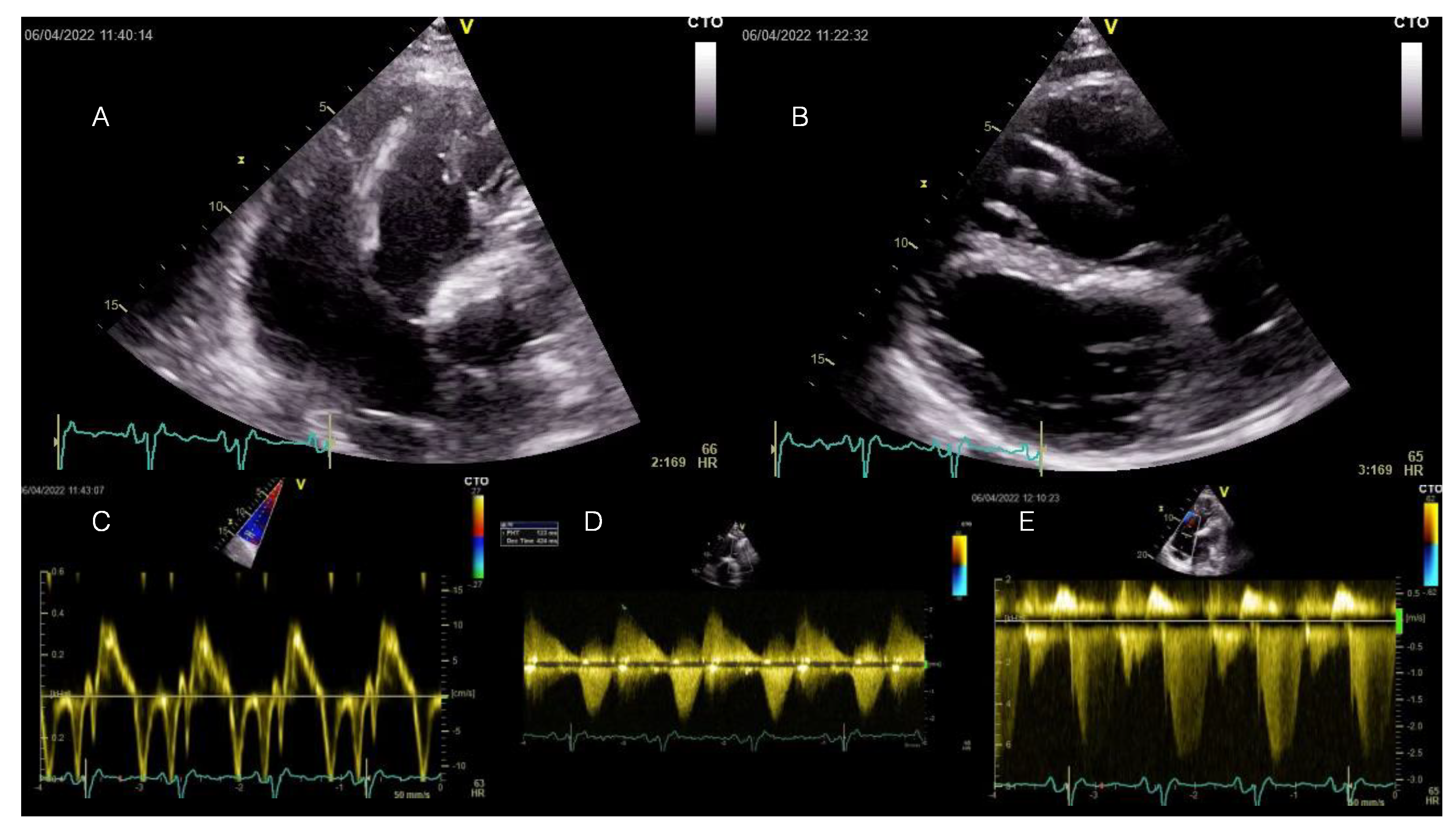Complex Substrate Leading to PVC-Mediated Systolic Dysfunction in addition to Sustained Monomorphic VT in Repaired Tetralogy of Fallot
Abstract
:Author Contributions
Funding
Institutional Review Board Statement
Informed Consent Statement
Data Availability Statement
Conflicts of Interest
References
- Zeppenfeld, K.; Schalij, M.J.; Bartelings, M.M.; Tedrow, U.B.; Koplan, B.A.; Soejima, K.; Stevenson, W.G. Catheter Ablation of Ventricular Tachycardia after Repair of Congenital Heart Disease Electroanatomic Identification of the Critical Right Ventricular Isthmus. Circulation 2007, 116, 2241–2252. [Google Scholar] [CrossRef] [PubMed]
- Andrade, A.C.; Jerosch-Herold, M.; Wegner, P.; Gabbert, D.D.; Voges, I.; Pham, M.; Shah, R.; Hedderich, J.; Kramer, H.-H.; Rickers, C. Determinants of Left Ventricular Dysfunction and Remodeling in Patients with Corrected Tetralogy of Fallot. J. Am. Heart Assoc. 2019, 8, e009618. [Google Scholar] [CrossRef]
- Egbe, A.C.; Pellikka, P.A.; Afzal, A.; Jain, V.; Thotamgari, S.; Miranda, W.R.; Connolly, H.M. Prognostic Implications of Left Ventricular Cardiomyopathy in Adults with Tetralogy of Fallot. CJC Open 2020, 2, 1–7. [Google Scholar] [CrossRef] [PubMed]
- McDonagh, T.A.; Metra, M.; Adamo, M.; Gardner, R.S.; Baumbach, A.; Böhm, M.; Burri, H.; Butler, J.; Čelutkienė, J.; Chioncel, O.; et al. 2021 ESC Guidelines for the diagnosis and treatment of acute and chronic heart failure: Developed by the Task Force for the diagnosis and treatment of acute and chronic heart failure of the European Society of Cardiology (ESC) with the special contribution of the Heart Failure Association (HFA) of the ESC. Eur. Heart J. 2021, 42, 3599–3726. [Google Scholar] [CrossRef] [PubMed]
- Krieger, E.V.; Zeppenfeld, K.; DeWitt, E.S.; Duarte, V.E.; Egbe, A.C.; Haeffele, C.; Lin, K.Y.; Robinson, M.R.; Sillman, C.; Upadhyay, S. Arrhythmias in Repaired Tetralogy of Fallot: A Scientific Statement from the American Heart Association. Circ. Arrhythmia Electrophysiol. 2022, 15, e000084. [Google Scholar] [CrossRef]
- Brouwer, C.; Kapel, G.F.L.; Jongbloed, M.R.M.; Schalij, M.J.; de Riva Silva, M.; Zeppenfeld, K. Noninvasive Identification of Ventricular Tachycardia–Related Anatomical Isthmuses in Repaired Tetralogy of Fallot: What Is the Role of the 12-Lead Ventricular Tachycardia Electrocardiogram. JACC Clin. Electrophysiol. 2018, 10, 1308–1318. [Google Scholar] [CrossRef] [PubMed]
- Khairy, P.; Harris, L.; Landzberg, M.J.; Viswanathan, S.; Barlow, A.; Gatzoulis, M.A.; Fernandes, S.M.; Beauchesne, L.; Therrien, J.; Chetaille, P.; et al. Implantable Cardioverter-Defibrillators in Tetralogy of Fallot. Circulation 2008, 117, 363–370. [Google Scholar] [CrossRef] [PubMed]
- Baumgartner, H.; De Backer, J.; Babu-Narayan, S.V.; Budts, W.; Chessa, M.; Diller, G.-P.; Lung, B.; Kluin, J.; Lang, I.M.; Meijboom, F.; et al. 2020 ESC Guidelines for the management of adult congenital heart disease. Eur. Heart J. 2021, 42, 563–645. [Google Scholar] [CrossRef]
- Briceño, D.F.; Santangeli, P.; Frankel, D.S.; Liang, J.J.; Shirai, Y.; Markman, T.; Enriquez, A.; Walsh, K.; Riley, M.P.; Nazarian, S.; et al. QRS morphology in lead V(1) for the rapid localization of idiopathic ventricular arrhythmias originating from the left ventricular papillary muscles: A novel electrocardiographic criterion. Heart Rhythm 2020, 17, 1711–1718. [Google Scholar] [CrossRef]
- Anderson, R.D.; Kumar, S.; Parameswaran, R.; Wong, G.; Voskoboinik, A.; Sugumar, H.; Watts, T.; Sparks, P.B.; Morton, J.B.; McLellan, A.; et al. Differentiating Right- and Left-Sided Outflow Tract Ventricular Arrhythmias: Classical ECG Signatures and Prediction Algorithms. Circ. Arrhythmia Electrophysiol. 2019, 12, e007392. [Google Scholar] [CrossRef]
- Al’Aref, S.J.; Ip, J.E.; Markowitz, S.M.; Liu, C.F.; Thomas, G.; Frenkel, D.; Panda, N.C.; Weinsaft, J.W.; Lerman, B.B.; Cheung, J.W. Differentiation of Papillary Muscle from Fascicular and Mitral Annular Ventricular Arrhythmias in Patients with and without Structural Heart Disease. Circ. Arrhythmia Electrophysiol. 2015, 8, 616–624. [Google Scholar] [CrossRef]
- Kapel, G.F.L.; Sacher, F.; Dekkers, O.M.; Watanabe, M.; Blom, N.A.; Thambo, J.-B.; Derval, N.; Schalij, M.J.; Jalal, Z.; Wijnmaalen, A.P.; et al. Arrhythmogenic anatomical isthmuses identified by electroanatomical mapping are the substrate for ventricular tachycardia in repaired Tetralogy of Fallot. Eur. Heart J. 2017, 38, 268–276. [Google Scholar] [CrossRef] [PubMed]
- Zeppenfeld, K.; Wijnmaalen, A.P. Clinical Aspects and Ablation of Ventricular Arrhythmias in Tetralogy of Fallot. Card. Electrophysiol. Clin. 2017, 9, 285–294. [Google Scholar] [CrossRef] [PubMed]
- Laredo, M.; Frank, R.; Waintraub, X.; Gandjbakhch, E.; Iserin, L.; Hascoët, S.; Himbert, C.; Gallais, Y.; Hidden-Lucet, F.; Duthoit, G. Ten-year outcomes of monomorphic ventricular tachycardia catheter ablation in repaired tetralogy of Fallot. Arch. Cardiovasc. Dis. 2017, 110, 292–302. [Google Scholar] [CrossRef] [PubMed]
- Evangeliou, A.P.; Ziogas, I.A.; Ntiloudi, D.; Mylonas, K.S.; Avgerinos, D.V.; Karvounis, H.; Giannakoulas, G. Radiofrequency catheter ablation for ventricular tachycardia in tetralogy of fallot: A systematic review. Int. J. Cardiol. Congenit. Heart Dis. 2021, 6, 100265. [Google Scholar] [CrossRef]
- Ait Ali, L.; Trocchio, G.; Crepaz, R.; Stuefer, J.; Stagnaro, N.; Siciliano, V.; Molinaro, S.; Sicari, R.; Festa, P. Left ventricular dysfunction in repaired tetralogy of Fallot: Incidence and impact on atrial arrhythmias at long term-follow up. Int. J. Cardiovasc. Imaging 2016, 32, 1441–1449. [Google Scholar] [CrossRef]
- Rotes, A.S.; Connolly, H.M.; Warnes, C.A.; Ammash, N.M.; Phillips, S.D.; Dearani, J.A.; Schaff, H.V.; Burkhart, H.M.; Hodge, D.O.; Asirvatham, S.J.; et al. Ventricular Arrhythmia Risk Stratification in Patients with Tetralogy of Fallot at the Time of Pulmonary Valve Replacement. Circ. Arrhythmia Electrophysiol. 2014, 8, 110–116. [Google Scholar] [CrossRef] [PubMed]
- Egbe, A.C.; Adigun, R.; Anand, V.; West, C.P.; Montori, V.M.; Murad, H.M.; Akintoye, E.; Osman, K.; Connolly, H.M. Left Ventricular Systolic Dysfunction and Cardiovascular Outcomes in Tetralogy of Fallot: Systematic Review and Meta-analysis. Can. J. Cardiol. 2019, 35, 1784–1790. [Google Scholar] [CrossRef]
- Goldenberg, I.; Moss, A.J.; Hall, W.J.; McNitt, S.; Zareba, W.; Andrews, M.L.; Cannom, D.S. Causes and consequences of heart failure after prophylactic implantation of a defibrillator in the multicenter automatic defibrillator implantation trial II. Circulation 2006, 113, 2810–2817. [Google Scholar] [CrossRef]
- Lumens, J.; Fan, C.S.; Walmsley, J.; Yim, D.; Manlhiot, C.; Dragulescu, A.; Grosse-Wortmann, L.; Mertens, L.; Prinzen, F.W.; Delhaas, T.; et al. Relative Impact of Right Ventricular Electromechanical Dyssynchrony versus Pulmonary Regurgitation on Right Ventricular Dysfunction and Exercise Intolerance in Patients after Repair of Tetralogy of Fallot. J. Am. Heart Assoc. 2019, 8, e010903. [Google Scholar] [CrossRef]
- Jing, L.; Haggerty, C.M.; Suever, J.D.; Alhadad, S.; Prakash, A.; Cecchin, F.; Skrinjar, O.; Geva, T.; Powell, A.J.; Fornwalt, B.K. Patients with repaired tetralogy of Fallot suffer from intra- and inter-ventricular cardiac dyssynchrony: A cardiac magnetic resonance study. Eur. Heart J. Cardiovasc. Imaging 2014, 15, 1333–1343. [Google Scholar] [CrossRef]
- Glikson, M.; Nielsen, J.C.; Kronborg, M.B.; Michowitz, Y.; Auricchio, A.; Barbash, I.M.; Barrabés, J.A.; Boriani, G.; Braunschweig, F.; Brignole, M.; et al. 2021 ESC Guidelines on cardiac pacing and cardiac resynchronization therapy: Developed by the Task Force on cardiac pacing and cardiac resynchronization therapy of the European Society of Cardiology (ESC) with the special contribution of the European Heart Rhythm Association (EHRA). Eur. Heart J. 2021, 42, 3427–3520. [Google Scholar] [CrossRef] [PubMed]
- Merchant, F.M.; Kella, D.; Book, W.M.; Langberg, J.J.; Lloyd, M.S. Cardiac resynchronization therapy in adult patients with repaired tetralogy of fallot and left ventricular systolic dysfunction. Pacing Clin. Electrophysiol. PACE 2014, 37, 321–328. [Google Scholar] [CrossRef] [PubMed]
- Janoušek, J.; Kovanda, J.; Ložek, M.; Tomek, V.; Gebauer, R.; Kubuš, P.; Delhaas, T. Cardiac Resynchronization Therapy for Treatment of Chronic Subpulmonary Right Ventricular Dysfunction in Congenital Heart Disease. Circ. Arrhythmia Electrophysiol. 2019, 12, e007157. [Google Scholar] [CrossRef] [PubMed]
- Janoušek, J.; Kovanda, J.; Ložek, M.; Tomek, V.; Vojtovič, P.; Gebauer, R.; Kubuš, P.; Krejčíř, M.; Lumens, J.; Delhaas, T.; et al. Pulmonary Right Ventricular Resynchronization in Congenital Heart Disease. Circ. Cardiovasc. Imaging 2017, 10, e006424. [Google Scholar] [CrossRef]
- Dubin, A.M.; Rosenthal, D.N. Right ventricular resynchronization: Moving beyond proof of concept. Heart Rhythm 2009, 6, 857–859. [Google Scholar] [CrossRef] [PubMed]
- Rodríguez-García, J.; Pijuan-Domenech, A.; Francisco-Pascual, J.; Dos-Subirà, L.; Miranda-Barrio, B.; Santos-Ortega, A.; Rivas-Gándara, N. Right ventricular resynchronization in a patient with repaired tetralogy of Fallot and severe ventricular dysfunction. Pacing Clin. Electrophysiol. PACE 2021, 44, 2119–2123. [Google Scholar] [CrossRef]
- Latchamsetty, R.; Bogun, F. Premature Ventricular Complex Ablation in Structural Heart Disease. Card. Electrophysiol. Clin. 2017, 9, 133–140. [Google Scholar] [CrossRef] [PubMed]
- El Kadri, M.; Yokokawa, M.; Labounty, T.; Mueller, G.; Crawford, T.; Good, E.; Jongnarangsin, K.; Chugh, A.; Ghanbari, H.; Latchamsetty, R.; et al. Effect of ablation of frequent premature ventricular complexes on left ventricular function in patients with nonischemic cardiomyopathy. Heart Rhythm 2015, 12, 706–713. [Google Scholar] [CrossRef]
- Marcus, G.M. Evaluation and Management of Premature Ventricular Complexes. Circulation 2020, 141, 1404–1418. [Google Scholar] [CrossRef]
- Zeppenfeld, K.; Tfelt-Hansen, J.; de Riva, M.; Winkel, B.G.; Behr, E.R.; Blom, N.A.; Charron, P.; Corrado, D.; Dagres, N.; de Chillou, C.; et al. 2022 ESC Guidelines for the management of patients with ventricular arrhythmias and the prevention of sudden cardiac death: Developed by the task force for the management of patients with ventricular arrhythmias and the prevention of sudden cardiac death of the European Society of Cardiology (ESC) Endorsed by the Association for European Paediatric and Congenital Cardiology (AEPC). Eur. Heart J. 2022, 43, 3997–4126. [Google Scholar] [CrossRef] [PubMed]



Disclaimer/Publisher’s Note: The statements, opinions and data contained in all publications are solely those of the individual author(s) and contributor(s) and not of MDPI and/or the editor(s). MDPI and/or the editor(s) disclaim responsibility for any injury to people or property resulting from any ideas, methods, instructions or products referred to in the content. |
© 2024 by the authors. Licensee MDPI, Basel, Switzerland. This article is an open access article distributed under the terms and conditions of the Creative Commons Attribution (CC BY) license (https://creativecommons.org/licenses/by/4.0/).
Share and Cite
Cojocaru, C.; Deaconu, S.; Gondos, V.; Onciul, S.; Petre, I.; Gheorghe-Fronea, O.; Vătășescu, R. Complex Substrate Leading to PVC-Mediated Systolic Dysfunction in addition to Sustained Monomorphic VT in Repaired Tetralogy of Fallot. Diagnostics 2024, 14, 158. https://doi.org/10.3390/diagnostics14020158
Cojocaru C, Deaconu S, Gondos V, Onciul S, Petre I, Gheorghe-Fronea O, Vătășescu R. Complex Substrate Leading to PVC-Mediated Systolic Dysfunction in addition to Sustained Monomorphic VT in Repaired Tetralogy of Fallot. Diagnostics. 2024; 14(2):158. https://doi.org/10.3390/diagnostics14020158
Chicago/Turabian StyleCojocaru, Cosmin, Silvia Deaconu, Viviana Gondos, Sebastian Onciul, Ioana Petre, Oana Gheorghe-Fronea, and Radu Vătășescu. 2024. "Complex Substrate Leading to PVC-Mediated Systolic Dysfunction in addition to Sustained Monomorphic VT in Repaired Tetralogy of Fallot" Diagnostics 14, no. 2: 158. https://doi.org/10.3390/diagnostics14020158




